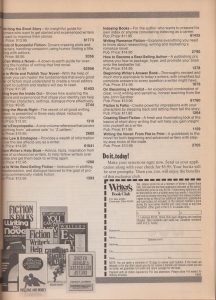How to Write Best Selling Fiction
See Also: Writing Popular Fiction
Trade Hardcover

Notes
“Some of the material appearing in this book originally appeared in Writing Popular Fiction, © 1972 by Dean R. Koontz.”
Listed as “Dean Koontz” on the spine.
Mentioned on page 243 of Richard Laymon’s A Writer’s Tale, Deadline Press, 1998.
Featured in an ad for the Writer’s Digest Book Club in The Basics of Writing & Selling Fiction vol. 2, 1984.


Alec Nevala-Lee interviews science fiction author Barry N. Malzberg
June 21, 2021
0:37:09
Nevala-Lee: At this point where you spending time or, you know, interacting with other writers?
Malzberg: Oh yeah.
Nevala-Lee: What were some of the writers you knew best?
Malzberg: The writers I knew best? Oh, Dean Koontz early in his career? Who is an agency client? [Bill] Pronzini, of course, with whom, I, we broke five novels together. Silverberg, of course. A lot of people. Varying degrees of acquaintances. Koontz and I, Pronzini and I, knew each other very well. They were very close friendships. Silverberg was miles ahead of me as a writer. But in Michael Swanwick’s words about about his own relationship with Silverberg, from the beginning [unintelligable] a human being. And we embarked upon in the early, the mid seventies upon a correspondence, which lasted 20 years. And he’s extraordinary.
Nevala-Lee: I wonder if you could talk a bit about Dean Koontz because I don’t think a lot of people realized that he had such a prolific career in science fiction. And, you know, mystery and other genres before he really broke through with novels for which he’s best known.
Malzberg: Yes, he did. Yes, he did and I was there to see all of it. He wanted to be a sicence ficiton writer by his own words in the early, in the early, the mids ’70s and he had published by that time several novels. He said I just realized, you know, it it wasn’t what, it wasn’t where I, what I wanted it to be or where I could go, so I had to go elsewhere. I want to interject, that Demon Seed that it became a movie as you may know. It was adapted from for a big deal movie but it was a novel and that and the other Bantam Novel The Flesh in the Furnace were written when he essentially given up [on Science Fiction], he had closed the doors and, and through mystery and suspense, was working his way out of it. But he was a very good science fiction writer. Better than he thought himself to be, and could have had a major career. And we know what happens to people who [unintellgiible] major careers in science fiction. So he was smart.
Nevala-Lee: One of the first books I ever read about writing was a book called Writing Popular Fiction, which…
Malzberg: Yeah I remeber that.
Nevala-Lee: …which Koontz wrote probably when he was in his late twenties and I still have copy.
Malzberg: He also wrote for Writer’s Digest Press, How to Write a Bestseller. [How To Write Best Selling Ficiton] Which I found amusing because at the time the book was published. He had not written a bestseller. He [eventually] did as we know.
Nevala-Lee: Yeah, the first book though is one that I basically memorized. I read him a lot growing up and I still think about some of the rules that he laid down for writing science fiction in particular.
Malzberg: Yeah. Yeah. He was quite sensible. There is, I agree with Vonnegut, writing cannot be taught, it can be learned, but it cannot be taught, but stipulating that, Koontz’s books were as good as any. No question.
0:40:36
Last updated on April 16th, 2018
